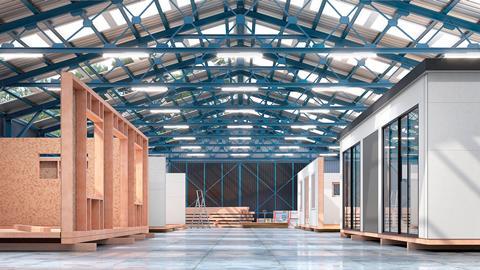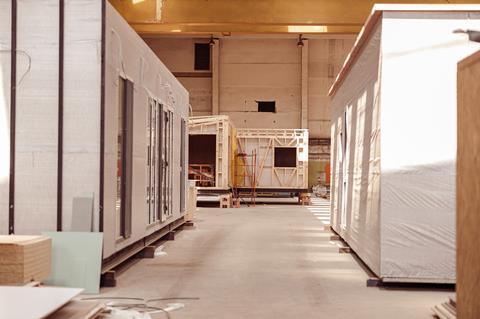Industry experts discussed how modern methods of construction can help the industry achieve the Future Homes Standard, at a rountable hosted by Building and Rockwool

If we are serious about achieving net zero carbon by 2050, the industry that contributes 40% of all CO2 has to be set tough but achievable goals – such as the Future Homes Standard.
Building magazine, in collaboration with Rockwool, gathered a panel of experts from across the housing industry to explore the role of modern methods of construction (MMC) in supporting the sector to meet the Future Homes Standard.
The panellists, chaired by Building special projects editor Jordan Marshall, explored the challenges and barriers to wider adoption of appropriate MMC measures, how they can be overcome, and the various MMC innovations that will help achieve sustainability goals.
Marshall kicked off by asking the panel about the role of MMC in supporting the industry.

The benefits of MMC
Jim Mitchell, design director at Stelling Properties, said he believes it’s “the future of construction and needs to be the way we do things moving forward”. Mitchell explained MMC solutions are seen as products and that product-led thinking is vital in tying the technologies together. With continuous improvement and innovation at the core of MMC, the days of working outside in bad weather are numbered.
Darren Jones, associate director at Shedkm, agreed: “There is an obvious benefit in terms of building in a factory environment. Your ability to get airtightness, to get continuity of insulation, to get all those details working as they should do is so much easier.” More rigorous quality control was also cited as another benefit. “The real key is continuing to drive innovation.”
Output before process
Tim Carey, chief product director at Collida, highlighted one of the issues with construction’s approach to MMC and the wider industry: “We focus on the process more often than the output.
“I recently bought an electric car because of what the car could do, not because I love the way Audi put the car together in the factory,” said Carey, who doesn’t believe the Future Homes Standard is enough and thinks it is important to make sure we are “outcome-focused first and let that drive the methodology”.
Steve Clift, chief commercial officer at TopHat, joined the discussion to share his perspective. “We’re already 65% below the Future Homes Standard in terms of embodied carbon,” but it’s not just because of modular systems, he said. “It’s to do with the fact that we build in timber and that we don’t use fossil fuels.”
It’s about keeping the heat inside the home and making the fabric more efficient
James Francis, Rockwool
Clift went on to say: “There are many better reasons why you would build in a modular way. It’s more efficient, it’s faster, and it has much higher quality.” But, he added: “It’s about being able to deliver what you say you’re going to deliver.”
Nigel Banks, R&D director at Ilke Homes, argued traditional construction can be done to a high standard but the difficulty comes in achieving that consistently. He said: “MMC is not about replacing traditional construction but about adding capacity.” Banks added that MMC could pave the way in showing how things can be done better and “raise the quality standards that are expected of new houses”.

Driving adoption
“As we continue to crank up the requirements of the homes that we live in, ultimately that will drive the adoption of all these modern technologies because there won’t be another way to achieve it,” added Carey. He doesn’t feel the government is moving quickly enough, “creating a time-bomb for decarbonising our [housing] stock further down the line”.
Banks believes that inspiring housebuilders could mean relying less on building regulations to raise the bar. “What we’ve been looking to do is demonstrate and inspire them to voluntarily go to higher standards. We’ve built some zero-bill homes, which from an economic view can sell for more than they cost to upgrade to.” They also offer mortgage affordability, which is increasingly important as interest rates go up.
Banks went on to argue there should be some requirement for all housebuilders’ homes’ performance to be analysed as part of the Building Regulations in 2025. “Direct feedback from the homes would raise the bar and give us real value data on their performance.”
Challenges with modular
Marshall circled back to the Future Homes Standard and asked the panellists: How challenging is it to meet the requirements?
“I think they are challenging and they need to be. Arguably, they maybe need to be more challenging,” said Jones. “But there are areas where MMC has challenges in responding to this – one is in the servicing strategy.” Regulations are turning to heat pumps as the default, but MMC tends to favour all-electric heating as it makes connections between modules much simpler.
Modular’s standardised approach could also create a challenge when looking at the orientation of your building. Jones believes it is about “standardising what we can but having a range of components within that that allow you to adapt a little more intelligently to the orientation you’re facing”.
Banks disagreed with regard to the use of heat pumps in modular designs. “We’ve been putting heat pumps into designs for quite some time. I don’t see that as a particular challenge for us; actually finding a space for water cylinders in traditional build houses is going to be harder,” he said.
“With high-performance glazing, [window size and orientation] has become less of an issue than it used to be. Overheating clearly needs to be considered,” he added.

Banks’ main issue with the Future Homes Standard is in relation to the embodied carbon that can come with the extra layer of glazing and insulation required: “It actually increases emissions and you don’t get those emissions back over time.”
“There’s a conversation around how much of a lingua franca we’ve got around what our carbon emissions are,” added Clift. “We’ve measured them in a deep empirical way, twice, and come up with very different numbers because the methodology is different.”
Clift went on to say: “The trade-off between embodied and operational carbon is inconclusive.” The standards Clift and his team spend a lot of time on is the interface between Part O and Part L, overheating and thermal performance. “We manage it and we get to pretty effective places down the middle, but we end up adding a lot of cost to our houses to get between those two. There’s room for a lot more innovation there.”
Specifying for MMC
Has there been movement on the supplier side, asked Marshall; are manufacturers creating the windows that you need? “They’re available but I wouldn’t say they’re mainstream,” answers Clift. “Having a window with the right combination of U- and G-value to hit both those two standards at once requires a bit more shopping around.”
James Francis, product manager at Rockwool, joined the discussion to talk about access to supplies and materials. “It’s the responsibility of manufacturers like Rockwool to go further in reinventing ourselves and improving on existing solutions, which is exactly what we’ve done this year.
“We’ve undergone a programme of research and innovation that’s led to the launch of NyRock technology. It’s a stepping stone to the Future Homes Standard as it delivers the most thermally efficient stone wool currently available in the UK and Ireland.
It’s all achievable. We’ve proved we can do it, but it means demanding more from ourselves and everyone we work with
Tim Carey, Collida
“Looking at Part L and the Future Homes Standard, heating homes is going to be on a lower temperature, so it’s about keeping the heat inside the home and making the fabric more efficient.”
At Collida the team has gone down the Passivhaus route to get to net zero carbon, which requires meeting all the U-values of the Future Homes Standard, which compared to a Passivhaus product is 20 times leakier.
“It’s all achievable,” said Carey. “We’ve proved we can do it, but it means demanding more from ourselves and everyone we work with.”
Mitchell also raised the issue of the durability of buildings: “How will they be performing in 10 to 15 years’ time?” Jones said he believes it is about finding a suitable format where the data can be compared meaningfully and shared so everyone across the industry can learn from it. Traditionally, that has not been construction’s strong point.
Waste not, want not
“Offsetting waste is a big opportunity for MMC,” said Mitchell. But then what do we do with the waste? “A fully controlled supply chain is something we all do really well, but also pushing our quality teams into the factories of our suppliers and making sure that they operate to the high standards that Rockwool do.”
Clift added to this: “Modular is a great way of reducing waste, but also it’s useful that the majority of the waste produced is in one location. That gives you a better opportunity to do something about it.”
Mitchell added: “Energy consumption at the factory is another thing that we need to offset. I think all of us would argue that that’s more than offset by the benefits it brings.”

Clift agreed: “There are some structural costs that we have that a traditional builder wouldn’t.”
How do we get sufficient efficiencies out of the remainder of the process to more than offset those? “The answer is: you can, but you need to be of a certain scale.”
The real challenge in modular is that you have a very volatile demand profile. Clift said: “With planning volatility and customer needs changing, getting that smooth input into your factory is very hard. If you’re saying modular is great because it’s fast and then your factory is full up over the next 9-12 months, that’s not actually a benefit to them. That’s why we are investing in such a large factory.”
Looking forward
All the panellists agreed that longevity is vital. “The biggest challenge for all housebuilders is to make sure the homes we build are easy to repair and maintain so they are kept in a good state and aren’t demolished in the future,” explained Banks.
Jones raised the interesting point of adaptability. “If a home is there for 200 years, people are going to want to do different things in the future. So it’s about designing with that in mind.”
He went on to say: “Embodied carbon and whole-life carbon metrics need to be much more understood within the industry. We need to be talking about them and understanding them, and that’s the first step towards reducing them.”
The biggest challenge for all housebuilders is to make sure the homes we build are easy to repair and maintain so they are kept in a good state and aren’t demolished in the future
Nigel Banks, Ilke Homes
For Francis, the key takeaway is a push for improved thermal performance, airtightness, reducing waste and lower embodied carbon. It’s important for manufacturers such as Rockwool and the industry to work together to develop the best possible solutions to benefit the homeowner and the wider industry too.
Nathan Hassall, business development manager at Rockwool, echoed this further: “It’s about using a sustainable fabric, one that’s not going to degrade over time,” and minimising the chances of another energy crisis like the one we’re facing at the moment.
Round the table
Chair: Jordan Marshall, special projects editor, Building
Nigel Banks, R&D director, Ilke Homes
Tim Carey, chief product director, Collida
Steve Clift, chief commercial officer, TopHat
James Francis, product manager, Rockwool
Nathan Hassall, business development manager, Rockwool
Darren Jones, associate director, Shedkm
Jim Mitchell, design director, Stelling Properties


























